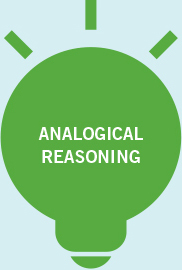Reasoning for Persuasive Speeches
In addition to providing your audience with a clear structure for your speech, you need to develop a logical basis for each of your main points. During the investigation step of your speech preparation, you collect facts, expert testimony, and specific examples. To turn all that material into the logical basis for your speech, first identify patterns in your supporting materials, and then summarize those patterns into arguments that become the main points of your speech. This process is known as reasoning. So if your thesis is “Playing the right video games can enhance your brainpower,” one of your main points (or arguments) might be, “Video gaming strengthens spatial skills.” Of course, it’s not enough to just state the point; your audience expects you to prove it. This is where your research comes in. Use your research findings to back up your claim by citing studies and expert testimony that illustrate how video gaming improves students’ spatial skills in educational settings.
There are many ways to use reasoning to support your ideas, but let’s focus on the four most common ones: deductive, inductive, analogical, and cause-

|

|

|

|
| Begin with a generally held principle, and back it up with specific instances. | Use specific, related facts to arrive at a general conclusion. | Draw a comparison between two ideas to show that their individual truths work in correlation. | Claim that one thing caused another based on an evident connection you’re able to draw between them. |
popcic/Shutterstock
Deductive Reasoning. When you start with a generally held principle and then show how a specific instance relates to that principle, you’re using deductive reasoning. Deductive reasoning typically has three elements: the major premise, or general statement you believe your audience will accept as true (“Honor students have disciplined study habits”); a minor premise, or specific instance of the general claim (“Ella is an honor student”); and a conclusion about the relationship between the two ideas (“Therefore, Ella must have disciplined study habits”).
Of course, your audience may not readily accept a major premise that’s very broad: “All honor students have disciplined study habits.” It might be more realistic and believable to say that most honor students have disciplined study habits. Words like most, probably, and likely are qualifiers—language that indicates how certain you are about your major premise (Toulmin, 1958). Your audience will be more likely to consider your broader claims when you use qualifiers and provide additional evidence to support them.
Inductive Reasoning. When you connect a set of specific, related facts to arrive at a more general conclusion, you’re using inductive reasoning. For example, if a new friend is late meeting you for an evening out, you’ll probably think nothing of it. But if it happens the next four or five times you get together, you’ll probably conclude that your friend isn’t capable of being on time. In a speech, you can use facts based on your personal observations or from the research you’ve compiled to arrive at a general conclusion.
When you’re using inductive reasoning, avoid outdated or limited examples. For instance, suppose a speaker said, “I will never eat at that restaurant again, and you shouldn’t either. Four years ago, they served me a soggy salad.” If you heard this, you might think to yourself, “Well, that was four years ago. Things might have changed a lot at the restaurant since then. I’m not sure this person knows what he’s talking about.” Your audience is likely to recognize when you don’t have enough adequate evidence to support your claim.
Analogical Reasoning. In Chapter 14, we discuss that when composing your speech, you can use analogies—comparisons of two unlike items—
To use analogical reasoning, you’ll need to show that the two things you’re comparing have significant similarities. Making false or unrealistic comparisons is not ethical. To gauge similarities in the recycling example, you would want to ask yourself questions like, Is the population of Springfield similar to that of our city? Are the financial resources similar? Are citizens similarly interested in participating in a recycling program? If the things you’re comparing are too different, you’ll find it harder to convince your audience that your claim makes sense.
Cause-
You can also claim that specific events or things will cause a particular effect in the future: “The use of performance-
When using cause-